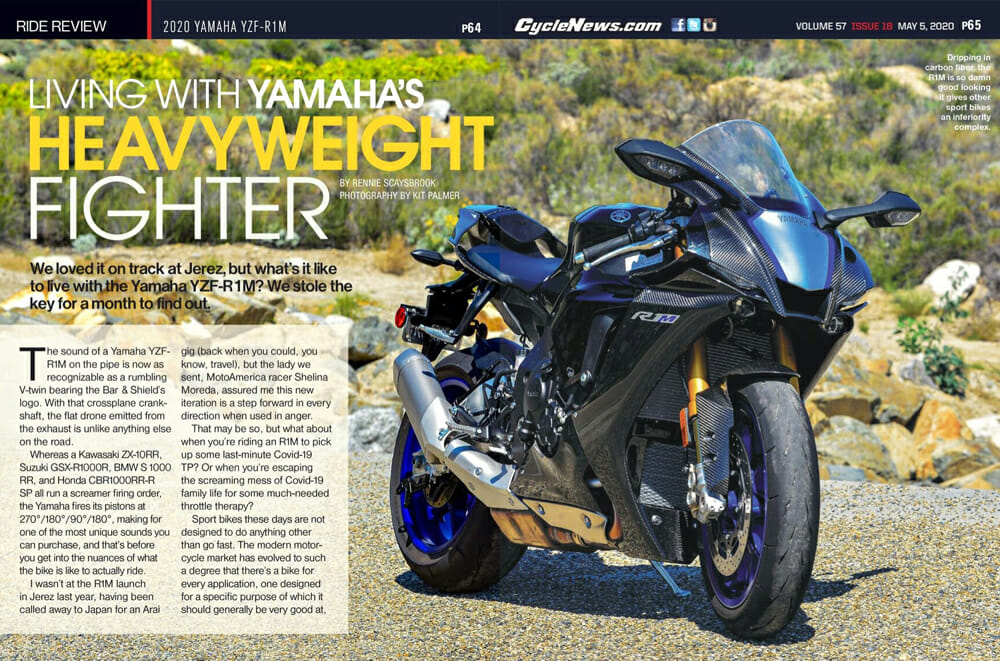Rennie Scaysbrook | May 11, 2020
We loved it on track at Jerez, but what’s it like to live with the Yamaha YZF-R1M? We stole the key for a month to find out.
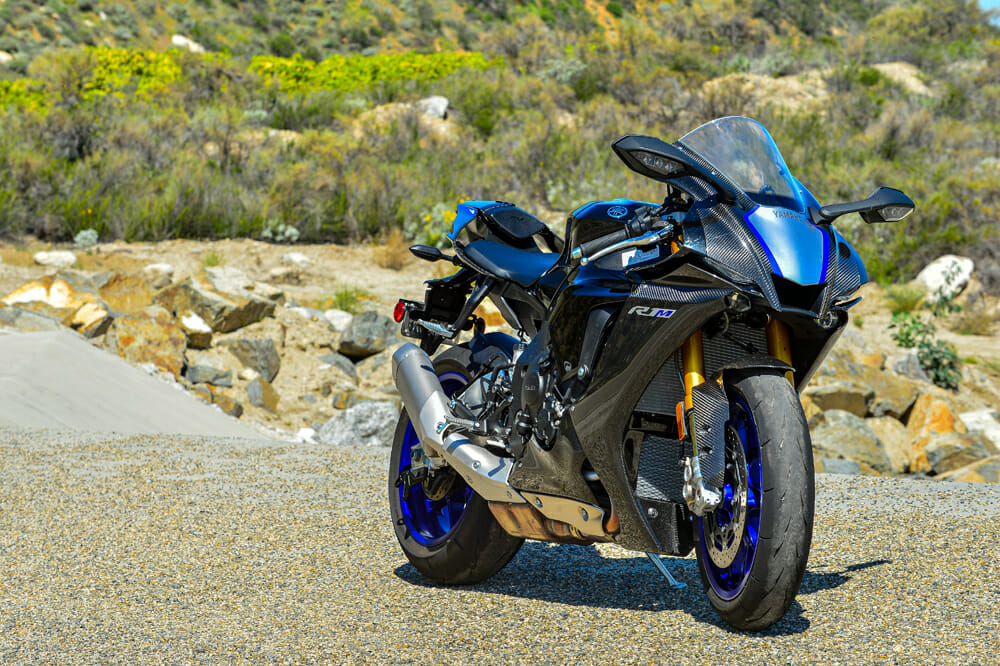 Dripping in carbon fiber, the R1M is so damn good-looking it gives other sportbikes an inferiority complex.
Dripping in carbon fiber, the R1M is so damn good-looking it gives other sportbikes an inferiority complex.
Photography by Kit Palmer
The sound of a Yamaha YZF-R1M on the pipe is now as recognizable as a rumbling V-twin bearing the Bar & Shield’s logo. With that crossplane crankshaft, the flat drone emitted from the exhaust is unlike anything else on the road.
Whereas a Kawasaki ZX-10RR, Suzuki GSX-R1000R, BMW S 1000 RR, and Honda CBR1000RR-R SP all run a screamer firing order, the Yamaha fires its pistons at 270°/180°/90°/180°, making for one of the most unique sounds you can purchase, and that’s before you get into the nuances of what the bike is like to actually ride.
I wasn’t at the R1M launch in Jerez last year, having been called away to Japan for an Arai gig (back when you could, you know, travel), but the lady we sent, MotoAmerica racer Shelina Moreda, assured me this new iteration is a step forward in every direction when used in anger.
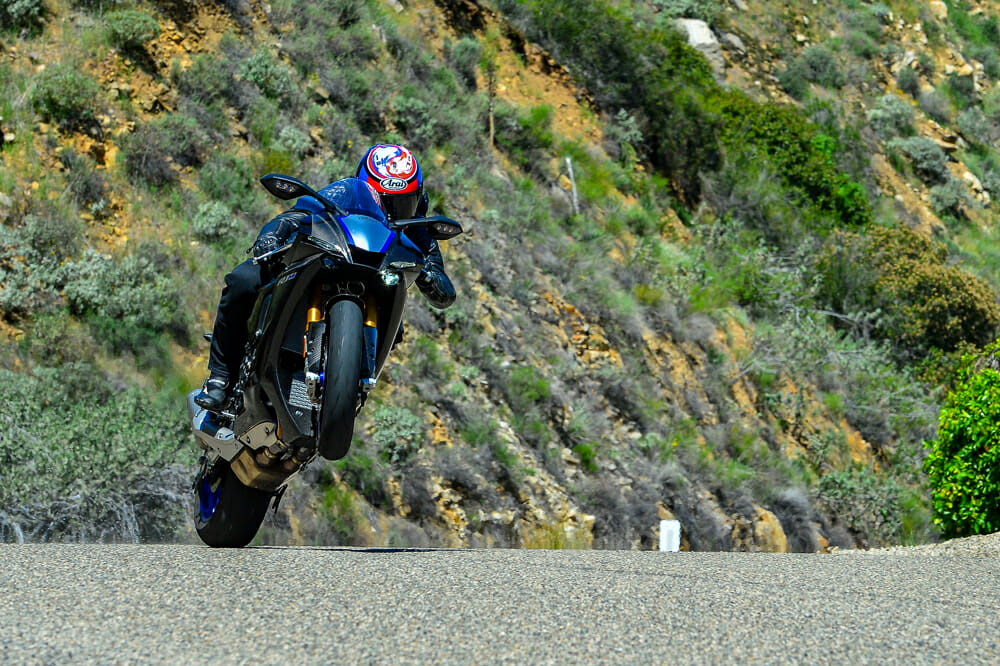 The wheelie control allows you to carry a little wheelie and style it for the camera. Of course, if you want to go full-send, you can switch the system off.
The wheelie control allows you to carry a little wheelie and style it for the camera. Of course, if you want to go full-send, you can switch the system off.
That may be so, but what about when you’re riding an R1M to pick up some last-minute Covid-19 TP? Or when you’re escaping the screaming mess of Covid-19 family life for some much-needed throttle therapy?
Sportbikes these days are not designed to do anything other than go fast. The modern motorcycle market has evolved to such a degree that there’s a bike for every application, one designed for a specific purpose of which it should generally be very good at, and not much else. The R1M is Yamaha’s top dog of superbike technology, so you could almost forgive it if it were rubbish at anything else other than going as fast as possible. Thankfully, this is not the case.
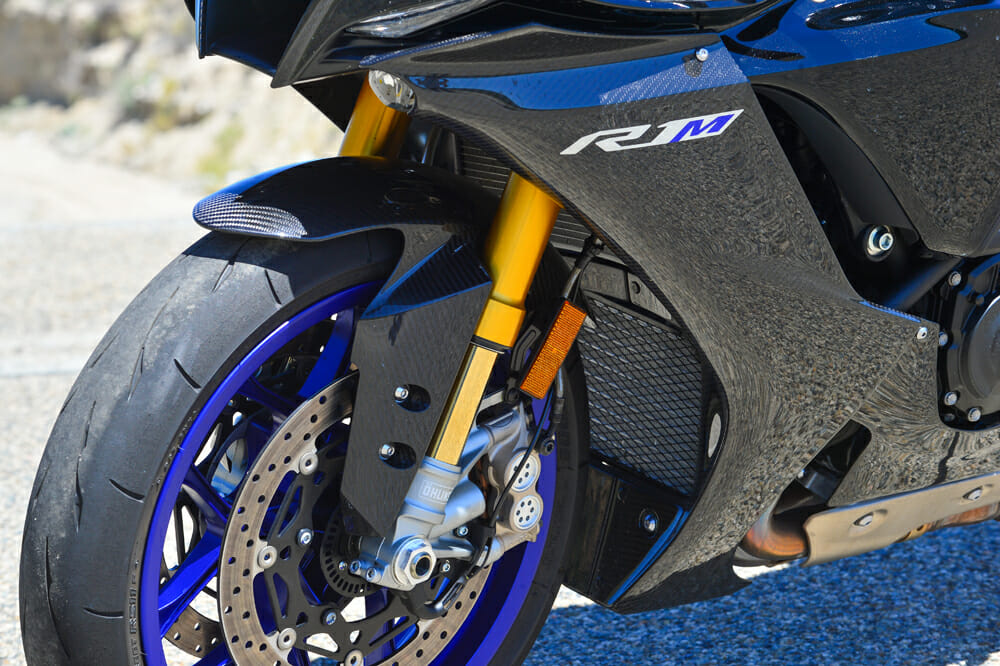 Öhlins gas-charged NPX-EC fork is a first for any production motorcycle.
Öhlins gas-charged NPX-EC fork is a first for any production motorcycle.
What’s New?
The YZF-R1 and R1M came in for a thorough overhaul for the 2020 model year. Engine-wise there was a top-to-bottom evaluation, with a new cylinder head, valves, cams, throttle bodies, the fuel injectors reduced from 12 holes to 10, and the oil pump rotor was reduced 2mm in diameter to 20mm.
The exhaust now holds a whopping four catalytic converters throughout its various bends, which is Yamaha’s only real option to keep power up in the high-190 horsepower region and still make it through the Euro 5 emission regulations. That adds weight to the equation, with the 2020 iteration topping the scales at a claimed 450 pounds, some seven pounds up on the 2018 model.
It may have gained a few pounds, but it’s also gained some special new hardware. In a first for a production motorcycle, Öhlins has fitted its gas-charged NPX-EC fork and TTX36 shock, both semi-active. Yamaha claims the new gas-charged fork reduces cavitation of the oil, where tiny air bubbles form and reduce the damping efficiency under hard track use.
To ride an R1M on the road is an exercise in restraint because this is a motorcycle you can ride at jail speeds and feel you could get off and run faster. Two factors come into play here—the first being that flat droning motor, but the second is how smooth the ride is via that electronically controlled suspension.
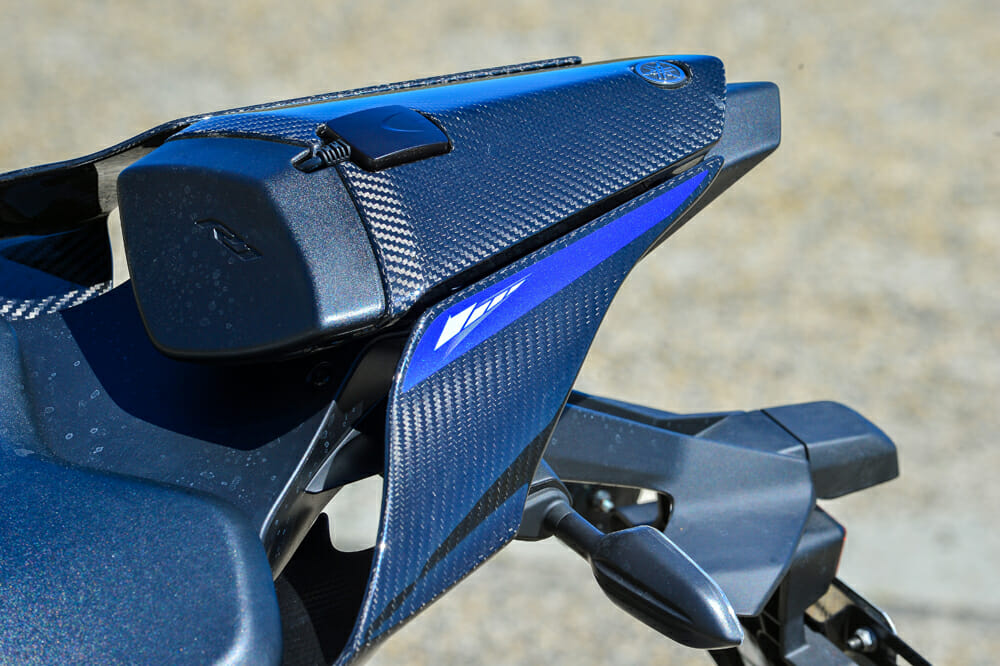 Go on, stare. We don’t mind.
Go on, stare. We don’t mind.
First, the motor. Although it sounds very much like the old one, the 2020 R1M’s now cable-less ride-by-wire throttle is creamy smooth, even if the engine falls a little flat if you’re lazy away from the lights. Put a bit of zest into leaving the line, have the motor above 3000 rpm, and drive is magnetic. The motor doesn’t feel dramatically different from what was on offer before—the revs still rise with a ferocity that makes you think you’ve got a 600 underneath you, and the four different riding modes allow you to dial in as vicious a throttle response as you like. I preferred the B Mode of the four power modes for street riding, simply as the initial power hit was a little easier to manage than in full-blown A Mode.
Our month with the bike netted a gas average of 23.12 mpg, not great, but it’s doubtful you’re spending the best part of $26K on a razor-sharp weapon like the R1M to be economical.
Being a liter bike, there’s no way you will get close to maxing out an R1M on the street unless you’re willing to put a few of your remaining years on the line in the Big House. There’s simply too much performance on offer—the kind of which was strictly reserved for WorldSBK not so long ago. So, to say the R1M is fast would be to state the bleeding bloody obvious. It’s more about what you can do with all that performance, which doesn’t necessarily have anything to do with the motor.
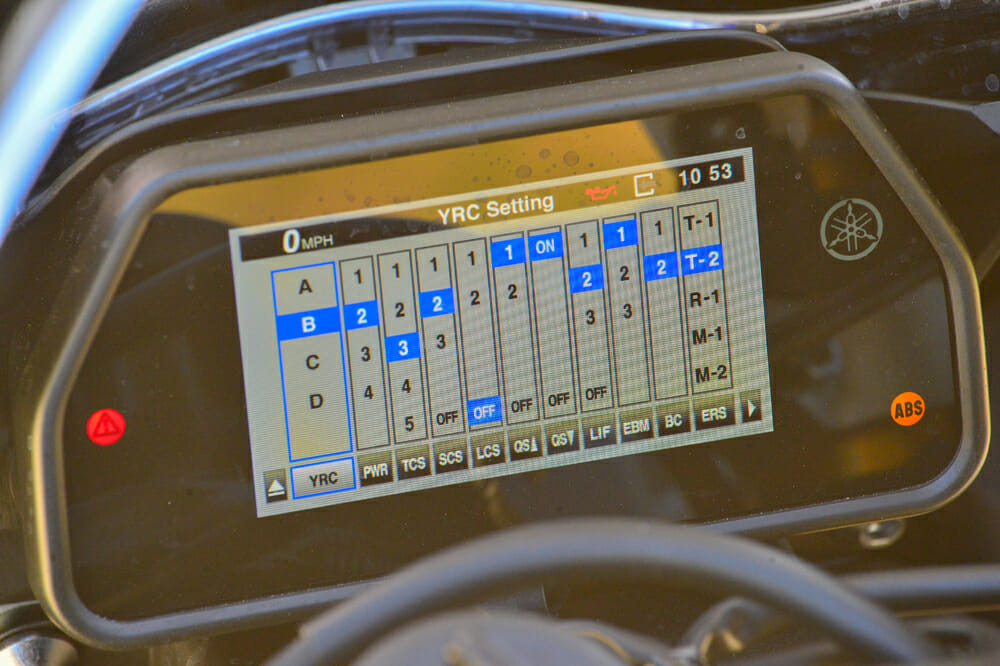 You’ll need a long time to test everything out here. Thankfully, Yamaha’s designers have made everything somewhat easy to understand for the average punter.
You’ll need a long time to test everything out here. Thankfully, Yamaha’s designers have made everything somewhat easy to understand for the average punter.
Options, Options
The R1M can be as docile or potent as you like, and you have five different suspension settings you can toggle between via the rolling switch on the right handlebar. Two manual modes (M-1 and M-2), a base road mode (R-1), and two track modes (T-1 and T-2) offer an enormous array of suspension possibilities—ride the R1M in either the T-1 or T-2 modes, and the ride becomes stiff, harsh and not at all pleasant. T-2 is somewhat bearable if you’re hauling after it but forget to change it back to R-1 and head over a potholed-strewn road, and you’ll know about it very quickly.
Being a bit on the fat and lazy side, I preferred R-1 for pretty much all my riding time with the R1M on the street. This setting doesn’t offer quite the same suspension poise as either of the two Track modes (manual mode means you can dial in as much or as little of any characteristic as you like), but the trade-off is a far more compliant ride, one that becomes almost sport touring-ish when traveling at sane (read: legal) speeds.
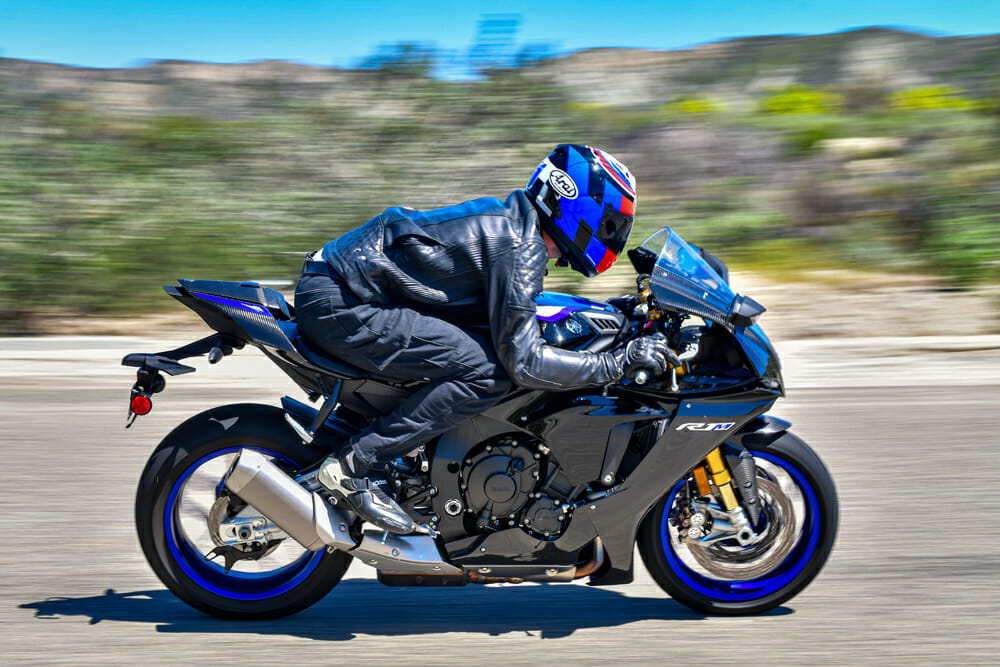 Add in leathers, and this crouch isn’t so comfy for 6’1” Rennie. You can see here the racy rider position the ergonomics offer.
Add in leathers, and this crouch isn’t so comfy for 6’1” Rennie. You can see here the racy rider position the ergonomics offer.
That’s the other thing with the R1M. The more you spend time with it, the more you find yourself immersed in the dash, which, I must say, is a touch on the small side. It’s the same dash as the 2015 edition, and the game has moved on since then. Anyway, I digress.
Inside that dash sits every adjustable electronic parameter—here’s what you can run through (all of which you can control on your phone via the integrated Communications Control Unit (CCU) data-logging and GPS system): four different power modes, 10-stage traction control, three slide-control settings, two-level launch control, two different quickshifter settings, three-stage lift (wheelie) control, three different engine brake settings, the five different suspension settings, and two-stage Brake Control. What’s Brake Control, you ask? Brake Control is Yamaha’s brake-by-wire system, which allows the ECU to interpret the amount of speed retardation you need, rather than what you may ask for. It’s electric brakes, basically. And this goes hand-in-hand with the new ABS module. The Advics brakes have always been one of the Yamaha’s weak points. From what a few colleagues have told me from the launch at Jerez last year, the system still isn’t up to par on the track despite the steel lines and upgraded four-piston calipers.
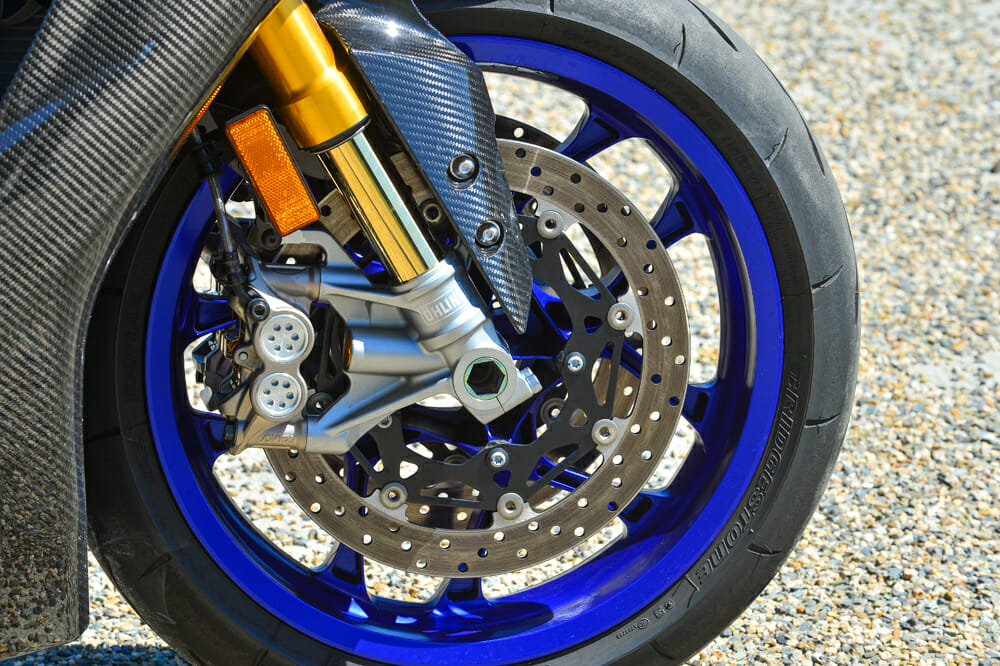 Brake performance on the track has been criticized by some testers, but on the street, we had no issues.
Brake performance on the track has been criticized by some testers, but on the street, we had no issues.
On the street, however, the system works fine. A rather spirited ride over Palomar Mountain in Southern California gave a touch of fade at the lever, but I had no complaints as to the effectiveness of the Brake Control system.
I did rather enjoy playing around with the various engine braking parameters on the R1M, which have been revised for this year. Level One gives you full four-stroke engine braking, but Level Two and especially Level Three provide such reduced engine braking it can feel at times like you’ve got a finger on the clutch. I resorted to Level One, as the extra engine braking helped pull the bike into the turn without having to use the rear brake as much. Still, I liked the fact there were three very different phases of engine braking available to the rider.
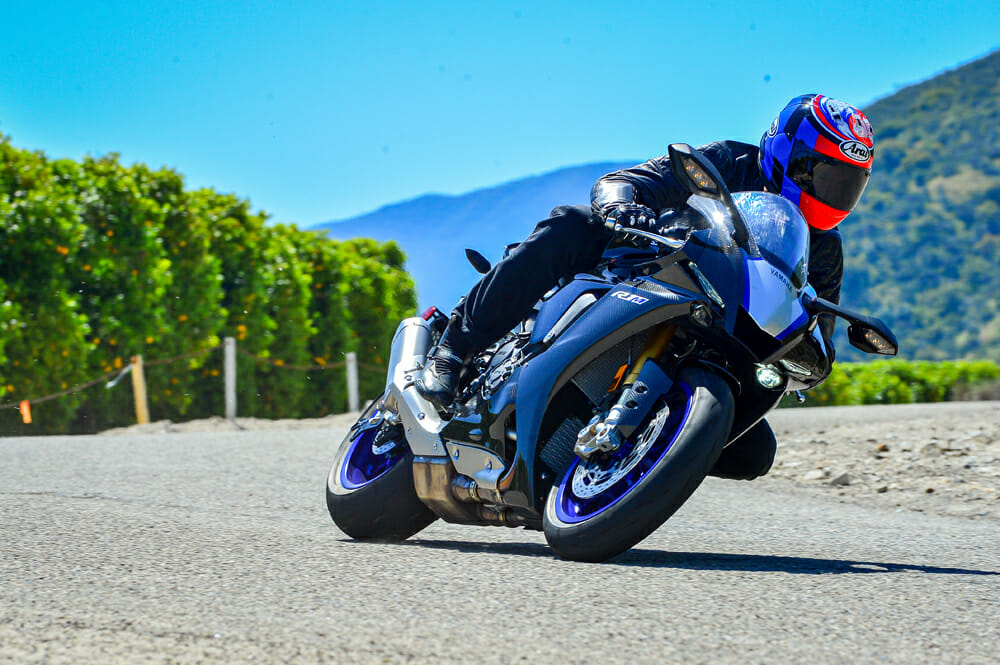 Bank the R1M into a corner, and it follows with almost fluid precision. It really does go as good as it looks.
Bank the R1M into a corner, and it follows with almost fluid precision. It really does go as good as it looks.
2020 Yamaha YZF-R1M Review—Would You?
Compared to the previous two superbikes I had last year in the Suzuki GSX-R1000R and the Honda CBR1000RR SP, the Yamaha’s ride position is much racier. The rider is hunched forward more, and there’s extra weight on your wrists, especially compared to the Suzuki. Also, the seat padding is not as comfortable as the Honda SP’s, so big days in the saddle get a bit uncomfortable. The Yamaha just encourages more, shall we say, speedy behavior than the other two—the Honda feels like an armchair compared to the R1M, while the cheap nature of the Suzuki’s cockpit gives it a feeling of inferiority.
Just oogling the Yamaha with a beer in one’s hand can take up many an hour. There’s so much stuff to look at, from the delectable carbon-fiber bodywork with one of the most Instagram-worthy butts of all time; to the new face that’s sleeker and deliberately copied off Maverick and Valentino’s M1; and the way the blue moves from the magnesium wheels to the outline of the front number plate, to the little M on the side of the fairing. The carbon fiber flows and glows in the afternoon light—this machine is pure class.
The Yamaha YZF-R1M turns heads like a model in Milan, with a build quality that makes the rather hefty ticket price of $26,099—more than a BMW S 1000 RR M Sport, Kawasaki ZX-10RR or GSX-R1000R, but, crucially, less than a Ducati Panigale V4 S or Honda CBR1000RR-R SP—absolutely worth it.CN
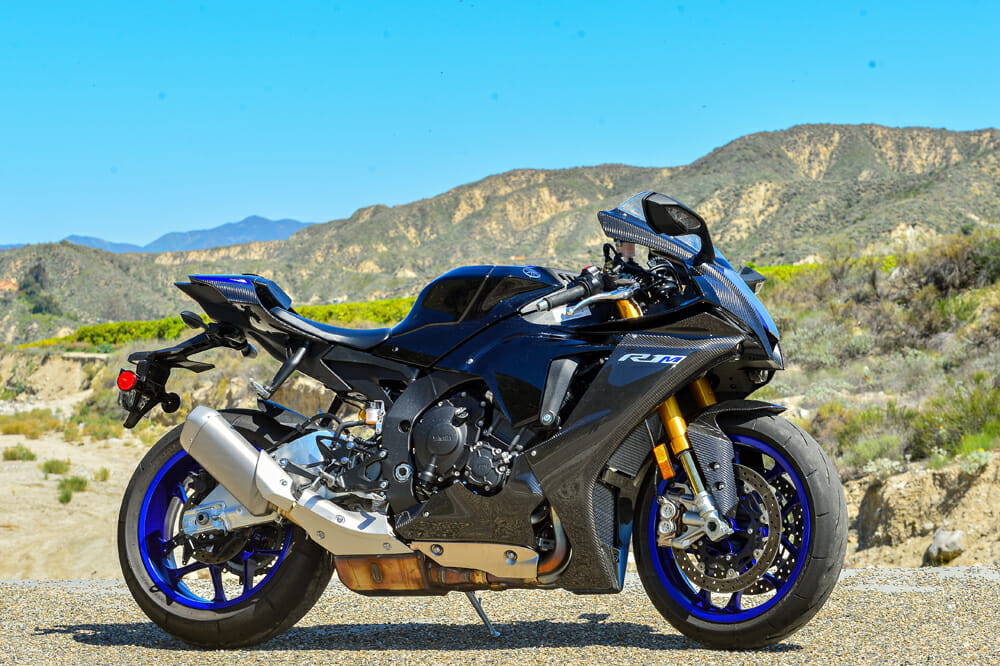
2020 Yamaha YZF-R1M Specifications
|
|
| MSRP: |
$26,099 |
| Engine: |
Liquid-cooled inline 4-cylinder DOHC; 16 valves |
| Displacement: |
998cc |
| Bore x stroke: |
79 x 50.9mm |
| Compression ratio: |
13.0:1 |
| Fuel delivery: |
Fuel injection with YCC-T and YCC-I |
| Transmission: |
6-speed cassette |
| Clutch: |
Wet, multiplate, slipper |
| Chassis: |
Twin-spar aluminum |
| Front suspension: |
43mm Öhlins Electronic Racing Suspension NPX fork, fully adjustable; 4.7-in travel |
| Rear suspension: |
Öhlins Electronic Racing Suspension single shock, fully adjustable; 4.7-in travel |
| Front-wheel travel: |
4.7 in. |
| Rear-wheel travel: |
4.7 in. |
| Front brake: |
Dual 320mm hydraulic disc; Brake Control System, ABS |
| Rear brake: |
Single 220mm hydraulic disc; Brake Control System, ABS |
| Front tire: |
120/70 ZR17 in. |
| Rear tire: |
200/55 ZR17 in. |
| Wheelbase: |
55.3 in. |
| Seat height: |
33.9 in. |
| Fuel capacity: |
4.5 gal |
| Weight: |
450 lbs. (ABS) |
| Colors: |
Carbon Fiber |
